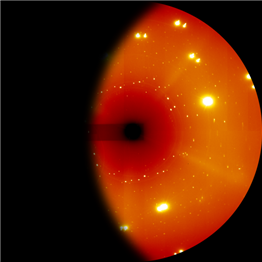Elusive Nitrogen Phase Exhibits Unexpected Complexity – Dr. Ross Howie
NOVEMBER 12, 2018
Although one might think that nitrogen, the primary constituent of the air which we breathe, is simple, it exhibits rich polymorphism across a wide range of extreme pressures and temperatures. Here a research team including HPSTAR members Jack Binns amd Ross Howie were able to experimentally resolve one of the most elusive forms of this model system, the dense solid iota-phase, that can only be accessed through a high temperature synthesis route. This work is published in Nature Communications (DOI: 10.1038/s41467-018-07074-4).
"As we heated the nitrogen sample, we could visually observe the structural transformation from the epsilon phase to the iota phase and see the phase boundary move across the sample chamber with time," said Ross Howie, and a video of this transition can be found in the supplemental information of the manuscript.
Through single crystal x-ray diffraction measurements (conducted at ESRF, France and PETRA-III, Germany), the crystal structure was determined to be unusually complex, consisting of 48 nitrogen molecules arranged in an intriguing layered structure. This sort of complexity in pure elements is usually only observed in metallic systems, such as the alkali metals. Despite numerous theoretical studies predicting nitrogen str uctures, none have found such a complex structure as this. With the experimental constraints, a theory group at the University of Edinburgh were able to navigate the energetic landscape of this highly polymorphic system and confirm the stability of the determined structure.
uctures, none have found such a complex structure as this. With the experimental constraints, a theory group at the University of Edinburgh were able to navigate the energetic landscape of this highly polymorphic system and confirm the stability of the determined structure.
'It is remarkable just how complex the crystal structure of this phase of nitrogen is, and could be an indication of the existence of more complex phases of simple molecular systems.' said Eugene Gregoryanz, who led this study.
Caption: X-ray diffraction pattern of ι–N2 at 56 GPa.
氮气作为空气中含量最多的气体,在极端条件下表现出一系列新的形态或者说结构。因此可以说压力会把原有简单的结构变得非常复杂。氮气因其在高压下的多态性而成为人们研究极端条件下的多相体系的参考。对于氮气的研究主要使用的是光谱学的探测。然而准确的晶体结构需要的是精确的X射线衍射数据。北京高压科学研究中心与爱丁堡大学合作的研究小组使用单晶X射线衍射的方法确定了氮气的高压相-ι–N2的晶体结构。他们发现这一高压相具有非常大的晶胞-由42个氮分子组成。“这一复杂的晶体结构通常只在单质金属中存在”,Howie研究员说到。“这意味着在简单的分子体系中也存在复杂的晶体结构”。
